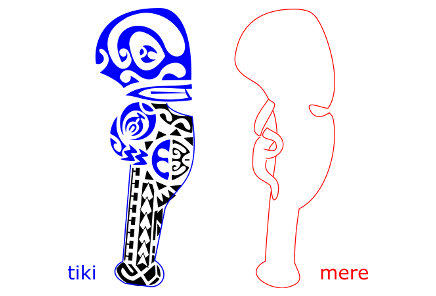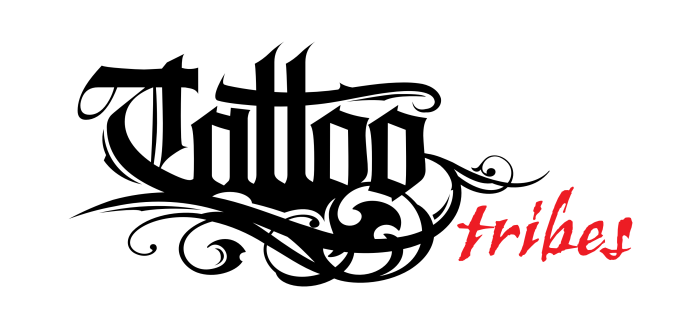The Challenge of "Reading" a Polynesian Tattoo

How to read and understand the meaning of a Polynesian tattoo is a question we've been asked many times over the years. The answer has been the same each time: it's not possible.
If you look at the two tattoos above, it's clear that they have different meanings and purposes, and that the one on the left relates to femininity whereas the one on the right must be related to a warrior.
Considering that each symbol can have several meanings, the way it is used and associated with other symbols allows it to represent different meanings and stories each time.
- The enata, for example, symbolizes a person. It could be a father in one tattoo, a friend in another, or the very wearer of the tattoo.
- The tiki is a protector, either a divinity or, oftentimes, a deified ancestor.
- The ipu symbolizes fertility, but it can represent good winds too, and it can be a symbol for ancestors, especially if paired with another mirrored ipu.
The Importance of Personal Narrative
The narrative behind each meaning is as important as the symbol itself, and the same happens with tattoos as a whole: it's not possible to say exactly what they represent, because each symbol acquires its correct meaning only if seen in the context of the whole tattoo and in relation to its specific story.
The only persons to know the exact meaning of each part of a Polynesian tattoo are the artist who prepares the tattoo and the person it was made for, and this only adds to the beauty of these tattoos as they are absolutely personal and the stories they tell remain private even if in plain sight.
Reading Clues: Size and Position
The bigger elements of a tattoo usually represent the most important aspects, while the smaller ones contribute to the details of the story. This way the position and size of the elements composing the tattoo can give us clues about its general meaning (e.g., family, protection, warrior) but we can't go much further if we try and read it without knowing its story.
Analysis Example: The Tiki and Mere Tattoo
Let's see an example analyzing the following tattoo:

Checking the design, the main element we see is the tiki (divinity, ancestor), which is enclosed in the general shape of a mere (a war club, and a chiefly symbol):

A further inspection allows us to identify several secondary elements:
- All-seeing eye (protection)
- Fish hook (prosperity)
- Chasing birds (support to the loved ones)
- Path of Kamehameha (challenging path)
- Spearheads (warrior, strength)
- Stepping stones (achievements, lessons)
- Adze (skills, hard work)
- Enata (person)
- Shark teeth (adaptability, protection)
- Sun (success, joy)
- Waves (change)
- Mountains (stability)
If we were to interpret the tattoo, we'd say it surely has to do with protection (tiki, all-seeing eye) and challenges faced bravely (spearheads, path of Kamehameha), leading to success (sun). It may also be related to status and respect (mere) and prosperity (fish hook). That's about all we can say for sure.
Let's now start from the real story, and then go back to the design: it's a memorial tattoo for a father (the tiki), who was a well known and respected person (the mere-like shape), who taught his son all that he knew (the stepping stones at the base) for him to take his place at the lead. (the tiki is holding the enata inside the sun, and the mere itself was handed down from one generation to the next). The father, a solid figure (the mountains), supported his son (chasing birds close to him) and made him prosperous (the fish hook nearby) by teaching him the necessary skills (adze and spearheads) to face every challenge bravely (the path of Kamehameha), preparing him for his new role at the lead (set within the sun) after his departure (the waves going away from the son toward the tiki, the deified ancestor).
Now that we know the real story, every symbol finds its place in it, and the meaning of each element becomes clear within the context of the whole tattoo.
Tattoos as Visual Aids to Narrative
So it's often possible to understand what a tattoo is about (family, protection, prosperity, warrior) but it's impossible to understand the exact story, or the meaning of each element, without knowing the story beforehand.
Tattoos, and all visual arts from Polynesia, always served the important purpose of being visual aids to a narrative, be it a personal story tattooed on skin, or a historical deed passed on orally from one generation to the next through the centuries. They're not just pretty designs.
Both the story and the design are equally important, and it's hard to understand the latter without knowing the story first. The intended bearer of a tattoo is the only person who really knows its meaning and who can therefore tap into its mana. A tattoo can enhance the mana of a person only if it resonates with their story. And when it does, anything can happen.

